#wolof langblr
Explore tagged Tumblr posts
Text
Kicking my feet and twirling my hair thinking about how Wolof conjugates pronouns instead of verbs
#i love grammar ok#I'm not saying I'm learning Wolof yet I'm just dabbling in it a bit for the fun of it#It's on my wishlist but I don't have the space to actually learn a third language at the moment#Especially with the school year being about to start#wolof langblr
6 notes
·
View notes
Text
Most commonly spoken language in each country
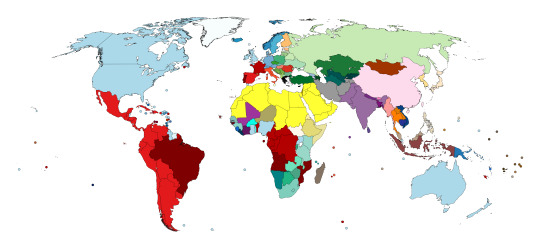

I had to separate the legend from the map because it would not have been legible otherwise. I am aware that the color distinctions are not always very clear, but there are only so many colors in the palette.
The legend is arranged in alphabetical order and languages are grouped by family (bullet points), with branches represented by numbers and followed by the color palette languages within them are colored in, as follows:
Afroasiatic
Chadic (Hausa) — ocher
Cushitic (Oromo and Somali) — light yellow-green
Semitic (from Arabic to Tigrinya) — yellow
Albanian — olive green
Armenian — mauve
Atlantic-Congo
Benue-Congo (from Chewa to Zulu) — blue-green
Senegambian (Fula and Wolof) — faded blue-green
Volta-Congo (Ewe and Mooré) — bright blue-green
Austroasiatic (Khmer and Vietnamese) — dark blue-purple
Austronesian
Eastern Malayo-Polynesian (from Fijian to Wallisian) — dark brown
Malayo-Polynesian (Palauan) — bright brown
Western Malayo-Polynesian (from Malagasy to Tagalog) — light brown
Eastern Sudanic (Dinka) — foral white
Hellenic (Greek) — black
Indo-European
Germanic (from Danish to Swedish) — light blue (creoles in medium/dark blue)
English-based creoles (from Antiguan and Barbudan to Vincentian Creole)
Indo-Aryan (from Bengali to Sinhala) — purple
Iranian (Persian) — gray
Romance (from Catalan to Spanish) — red (creoles in dark red)
French-based creoles (from Haitian Creole to Seychellois Creole)
Portuguese-based creoles (from Cape Verdean Creole to Papiamento)
Slavic — light green (from Bulgarian to Ukrainian)
Inuit (Greenlandic) — white
Japonic (Japanese) — blanched almond
Kartvelian (Georgian) — faded blue
Koreanic (Korean) — yellow-orange
Kra-Dai (Lao and Thai) — dark orange
Mande (from Bambara to Mandinka) — magenta/violet
Mongolic (Mongolian) — red-brown
Sino-Tibetan (Burmese, Chinese*, and Dzongkha) — pink
Turkic (from Azerbaijani to Uzbek) — dark green
Uralic
Balto-Finnic (Estonian and Finnish) — light orange
Ugric (Hungarian) — salmon
* Chinese refers to Cantonese and Mandarin. Hindi and Urdu are grouped under Hindustani, and Bosnian, Croatian, Montenegrin, and Serbian are grouped under Serbo-Croatian.
#langblr#lingblr#spanish#english#french#german#catalan#russian#mandarin#hausa#somali#arabic#albanian#armenian#swahili#ewe#moore#wolof#vietnamese#samoan#palauan#malay#dinka#greek#tok pisin#hindustani#persian#haitian creole#papiamento#greenlandic
57 notes
·
View notes
Text
http://teach.italki.com/application
The website “italki” offers the possibility to learn or teach over 130 languages. Each teacher sets their own fees, and it is not necessary to have a degree or certification to teach. There are several million users, and over 5000 English teachers, but very few teachers for African languages such as Yoruba (7 teachers), Tamazight (6 teachers), Wolof (2 teachers), Sudani Arabic (1 teacher), Tigrinya (1 teacher), Somali (1 teacher), Amharic (1 teacher)... No Bambara teacher, no Fula teacher, no Oromo teacher, no Kinyarwanda teacher... Same with several Caribbean, Eastern European, South Asian or West Asian languages : Pashto, Kurdish, Chechen, Tamul, Albanese and Haitian Creole all have less than 20 teachers. Sign language (in all its varieties) also has less than 20 teachers. And almost none of the North, Central or South American indigenous languages that the website offers have any teacher at all : Lakota, Nahuatl, Wayuu, Cherokee, Cree, Choctaw, Navajo (diné bizaad), Guambiano (namtrik/misak)... all of them have 0 teachers. And none of the varieties of Rroma language (Rromani) that the website offers have any teacher either. Of course because of eurocentric linguistic and cultural hegemony and imperialism, it’s expected that there be less demand for these languages than for English, French or Spanish, and therefore it makes sense that there are less teachers. But still, I feel like someone who speaks one of these languages could get a decent amount of money by teaching online on Italki. There is not much competition so you could get a lot of students. The website charges 15% of your earnings, but you can set your own prices. For example, one of the only 2 Wolof teachers on the website started teaching in February of this year. She has great reviews and feedback from her students. Since February, she has given 30 half-hour trial lessons for 7,99$, 10 conversation lessons for 10,99$ to 21,99$ depending on duration, and 21 grammar & vocabulary lessons for 11,99$ to 34$ depending on duration. Imagining all the lessons she taught were the shortest (30 minutes) thus cheapest ones, she would have made approximately 500$ teaching Wolof since February, after deducting the 15% commission the website charges. In Senegal, 500$ is a lot of money, almost 1400 times the minimum hourly wage per hour, for teaching 30 hours. And the most likely is that not all of her classes lasted 30 minutes, so she probably made even more than 500$. So, if you or someone you know speaks one of these languages and needs money, that could be an interesting option!
#italki#langblr#languages#african languages#asian languages#indigenous languages#job opportunity#teaching opportunities#teaching opportunity#oromo#pashto#somali#wolof#bambara#amharic#lakota#navajo#cherokee#kurdish#tamul#tamil#haitian creole
88 notes
·
View notes
Text
100 Happy Days Langblr (3/100)

🥳 Bursdagsoverraskelse for en kollega 🎂
Kollegaen min Aminata feiret bursdagen sin i dag, så kollegene mine og jeg overrasket henne med en kake akkurat da hun skulle være ferdig med å undervise en seminar. Vi stormet inn i klasserommet med kaken og sang burdagssangen, først på engelsk, så på fransk, og til slutt på wolof. Det var etterfulgt av det som føltes som en million gruppebilder og en seremoniell kakeskjæring.
Aminata er ikke bare min kollega, men også min samboer. Vi deler en leilighet i Bijilo og arbeider for samme organisasjon i ulike prosjekter. Etter jobb eller i helgene går vi av og til ut sammen. Hun har lært meg litt wolof, og takket være henne har jeg også lært mer om heimlandet hennes, Senegal 🇸🇳
Bés bu dellusi moo neex, suma xarit! ♥️
#100happydayslangblr#norwegian#norsk#langblr#a sprinkle of wolof today#rettelser alltid velkomne#norwegian langblr
1 note
·
View note
Text
One of the best speaking tips my English teacher told as was to never think in our native language translate then speak, it would affect the flow and he was so right about it cause I’ve noticed when I want to speak in Japanese I first think of the English or Arabic word then translate it to the Japanese one and it really affects my flow unlike when I just speak naturally.
if you have any difficulty with speaking just try this way it really works :)
7 notes
·
View notes
Text
Langblr activation challenge
Week 2: Promote other langblrs
This is a non exhaustive list of langblrs who post about all sorts of languages and whose content I really enjoy!!
@tealingual - Finnish, English, Japanese, German, Swedish, Arabic, Northern Sámi, Ainu @latenightlangblrs - Hebrew, English, German, Arabic, Russian @ich-bin-der-baer - English, German, Swedish @blumensprache - Polish, English, German, Spanish, French @wordsinpersian - Persian @blunderinglangblr - English, Spanish, Japanese, German, Lithuanian @salvadorbonaparte - German, English, Spanish @guillemelgat - English, Catalan, Basque, Welsh, Romani, Malayalam, Western Abenaki, Tamasheq, Kurdish, Bosnian, Amharic, Wolof, Bambara @gwendolynlerman - Spanish, French, German, Russian, Mandarin @lalala-languages - English, German, Portuguese, Korean, Arabic, Latin @lagom-languages - English, German, Serbian, Te Reo Māori, Italian @gut-gemacht-mien-deern - English, German, French @diedeutschehexe - German, Norwegian @orkanstudies - English, German @mediocrelanguagelearner - Czech, English, German, Spanish, Swedish @hownottolearnalanguage - Japanese, Indonesian, French, Finnish, Arabic, German @linguenuvolose - Swedish, English, Italian, French, Dutch, German, Maltese, Old Norse @polysprachig - English, German, Greek, Irish, French, Italian, Russian @languagesruletheworld - German, English, Spanish, French, Norwegian, Polish, Dutch @the-caravan-languages - Farsi, Urdu, Turkish, Arabic, Hebrew
linguistics bonus round:
@mypling @linguisten @sociolinguo
#please let me know if any of this is wrong#langblractivationchallenge#Langblr Activation Challenge#mine#langblr
50 notes
·
View notes
Photo

INKTOBER — LANGBLR EDITION
Japanese, Persian, French, Dutch, Russian, Xhosa, Norwegian, Finnish, Arabic, German, Turkish, Wolof, Swedish, Korean, Ladino, Urdu, Greek, Welsh, Romanian, Yiddish, Afrikaans, Gothic, Sesotho, Northern Sámi, Croatian, Frisian, Mongolian, Nepali, Malay/Indonesian, Navajo, Toki Pona
14 notes
·
View notes
Text
Resources Master Post
My General Resources Tag (X)
For Your Bujo
My General Bujo Tag (X)
Cute Quotes To Put In Your Bujo (X)
Inspiration (X)
Layout Printables (X)
Printables & Notes
My General Printables Tag (X)
Foreign Language Learning Printables (X)
Calendars (X)
Planners (X)
Misc Printables (X)
Organizational Printables (X)
Note-taking Printables (X)
Ready Written Notes (X)
Flashcards (X)
Power Points (X)
Resources By Subject
Anatomy & Physiology (X)
Architecture (X)
Art (X)
Art History (X)
Astronomy (X)
Botany (X)
Chemistry (X)
Computer Science (X)
Dental (X)
Dietetics & Nutrition (X)
Ecology (X)
Economics (X)
Engineering (X)
General Math (X)
General Sciences (X)
Geometry (X)
Grammar (X)
History (X)
Law (X)
Linguistics (X)
Literature (X)
Marine Biology (X)
Medical (X)
Music (X)
Mythology (X)
Nursing (X)
Organic Chemistry (X)
Physics (X)
Writing (X)
Zoology (X)
Foreign Language Studies
My General Langblr Tag (X)
Afrikaans (X)
Albanian (X)
Alsatian (X)
American Sign Language (X)
Amharic (X)
Antillean Creole (X)
Arabic (X)
Armenian (X)
Avestan (X)
Basque (X)
BCSM (Bosnian-Croatian-Serbian-Montenegrin) (X)
Bemba (X)
Bengali (X)
Bikol (X)
Breton (X)
Bulgarian (X)
Burmese (X)
Cantonese/Chinese/Mandarin (X)
Catalan (X)
Cebuano (X)
Chewa (X)
Corsican (X)
Crioulo (X)
Croatian (X)
Czech (X)
Danish (X)
Dutch (X)
Egyptian Hieroglyphics (X)
English (X)
Esperanto (X)
Estonian (X)
Farsi (X)
Filipino (X)
Finnish (X)
French (X)
Frisian (X)
Fula (X)
Gaelic Scottish (X)
Galician (X)
Georgian (X)
German (X)
Greek (X)
Guarani (X)
Gujarati (X)
Haitian Creole (X)
Hausa (X)
Hawaiian (X)
Hebrew (X)
Hiligaynon (X)
Hindi (X)
Hungarian (X)
Icelandic (X)
Ilokano (X)
Indonesian (X)
Irish (X)
Italian (X)
Ivatan (X)
Japanese (X)
Kabyle (X)
Kanuri (X)
Kazakh (X)
Kirghiz (X)
Korean (X)
Latin (X)
Latvian (X)
Lithuanian (X)
Luganda (X)
Malagasy (X)
Malay (X)
Maltese (X)
Mandinka (X)
Marshallese (X)
Mongolian (X)
Nepali (X)
Norwegian (X)
Occitan (X)
Ojibwe (X)
Old Norse
Panjabi (X)
Papiamentu (X)
Pashto (X)
Persian (X)
Polish (X)
Portuguese (X)
Punjabi (X)
Quebecois French (X)
Quenya (X)
Romani (X)
Romanian (X)
Russian (X)
Samoan (X)
Sanskrit (X)
Scots (X)
Serbian (X)
Sesotho (X)
Setswana (X)
Sinhala (X)
Slovak (X)
Slovene (X)
Spanish (X)
Swahili (X)
Swedish (X)
Swiss German (X)
Tagalog (X)
Tamazight (X)
Tamil (X)
Tashelheet (X)
Thai (X)
Tok Pisin (X)
Toki Pona (X)
Turkish (X)
Turkmen (X)
Twi (X)
Ukrainian (X)
Urdu (X)
Uzbek (X)
Vietnamese (X)
Welsh (X)
Wolof (X)
Xhosa (X)
Yiddish (X)
Yoruba (X)
Zulu (X)
Books & Textbooks
Textbooks (X)
Books (X)
Health & Beauty
My General Beauty Tag (X)
My General Health Tag (X)
Recipes (X)
Makeup & Skin Care (X)
Self-Care (X)
Vegan (X) (I tag this separately as I know some people may not care for/like veganism)
Misc.
My General Misc. Tag (X)
Art & Pictures (X)
Applications (X)
Bands & Musicians (X)
Master Posts (X)
Stationery (X)
Websites (X)
970 notes
·
View notes
Text
Currently working on a playlist of Wolof music for the fun of it, so if you have any recommendations, don't hesitate!
#wolof#wolof langblr#wolof music#i'm gonna be making playlists for all of my wishlist languages at some point so this is just the first of many
0 notes
Video
youtube
<3
#ivory coast#lingala#congo#algeria#french#france#video#microtrottoir#french youth#paris#languages#langues#langblr#arabic#dialects#creole#west indies#korean#japanese#wolof#senegal#mali#turkish#immigration#multiculturalism#algerian arabic#tunisian arabic#kabyle#amazigh#dioula
8 notes
·
View notes
Text
I See You

Name: Senegal
Demonym: Senegalese
Etymology: Senegal is translated from the Wolof “sun gal” to mean “our boat”.
Capital: Dakar
Motto: "Un Peuple, Un But, Une Foi" (French)
"One People, One Goal, One Faith"
Location: West Africa
Population: 16,313,742 (2018)
Religion: Islam is the predominant religion in the country, practiced by approximately 94% of the country’s population; the Christian community, at 5% of the population, are mostly Roman Catholics.
Climate: Sahelian
Language(s) Spoken: French and Wolof
National Languages: Balanta-Ganja, Hassaniya Arabic, Jola-Fonyi, Mandinka, Mandjak, Mankanya, Noonm, Pulaar, Serer, Soninke
Currency: CFA franc (XOF)
Independence Day:
- From France 4 April 1960
- Withdrawal from the Mali Federation 20 August 1960
Flag meaning: The red, yellow and green are the official Pan-African colors, and the centered star is symbolic of hope and unity.
Brief History
Archaeological findings throughout the area indicate that Senegal was inhabited in prehistoric times and has been continuously occupied by various ethnic groups.
Some kingdoms were created around the 7th century: Takrur in the 9th century, Namandiru and the Jolof Empire during the 13th and 14th centuries. Eastern Senegal was once part of the Ghana Empire.
Islam was introduced through Toucouleur and Soninke contact with the Almoravid dynasty of the Maghreb, who in turn propagated it with the help of the Almoravids, and Toucouleur allies.
This movement faced resistance from ethnicities of traditional religions, the Serers in particular.
In the 13th and 14th centuries, the area came under the influence of the empires to the east; the Jolof Empire of Senegal was also founded during this time.
In the 14th century the Jolof Empire grew more powerful, having united Cayorand the kingdoms of Baol, Sine, Saloum, Waalo, Futa Tooro and Bambouk, ormuch of present day West Africa.
The empire was a voluntary confederacy of various states rather than an empire built on military conquest.
The empire was founded by Ndiadiane Ndiaye, a part Serer and part Toucouleur, who was able to form a coalition with many ethnicities, but collapsed around 1549 with the defeat and killing of Lele Fouli Fak by Amari Ngone Sobel Fall.
Colonial Era
In the mid-15th century, the Portuguese landed on the Senegal coastline, followed by traders representing other countries, including the French.
Various European powers-Portugal, the Netherlands, and Great Britain-competed for trade in the area from the 15th century onward.
In 1677, France gained control of what had become a minor departure point in the Atlantic slave trade-the island of Gorée next to modern Dakar, used as abase to purchase slaves from the warring chiefdoms on the mainland.
European missionaries introduced Christianity to Senegal and the Casamance in the 19th century.
It was only in the 1850s that the French began to expand onto the Senegalese mainland after they abolished slavery and began promoting an abolitionist doctrine, adding native kingdoms like the Waalo, Cayor, Baol, and Jolof Empire.
French colonists progressively invaded and took over all the kingdoms except Sine and Saloum under Governor Louis Faidherbe.
Senegalese resistance to the French expansion and curtailing of their lucrative slave trade was led in part by Lat-Dior, Damel of Cayor, and Maad a Sinig Kumba Ndoffene Famak Joof, the Maad a Sinig of Sine, resulting in the Battle of Logandème.
Independence (1960)
On April 4, 1959 Senegal and the French Sudan merged to form the Mali Federation, which became fully independent on 20 June 1960, as a result of a transfer of power agreement signed with France on 4 April 1960.
Due to internal political difficulties, the Federation broke up on 20 August, when Senegal and French Sudan each proclaimed independence.
Léopold Sédar Senghor was Senegal's first president in September 1960.
Senghor was a very well-read man, educated in France.
In 1980, President Senghor decided to retire from politics.
Former prime minister Mamadou Dia, who was Senghor's rival, ran for election in 1983 against Diouf, but lost.
Senghor moved to France, where he died at the age of 96.
Senegal joined with the Gambia to form the nominal Senegambia Confederation on 1 February 1982.
Despite peace talks, a southern separatist group in the Casamance region has clashed sporadically with government forces since 1982 in the Casamance conflict.
In the early 21st century, violence has subsided and President Macky Sall heldtalks with rebels in Rome in December 2012.
He encouraged broader political participation, reduced government involve mentin the economy, and widened Senegal's diplomatic engagements, particularly with other developing nations.
Domestic politics on occasion spilled over into street violence, border tensions, and a violent separatist movement in the southern region of the Casamance. Nevertheless, Senegal's commitment to democracy and human rights strengthened.
In the presidential election of 1999, opposition leader Abdoulaye Wade defeated Diouf in an election deemed free and fair by international observers. Senegal experienced its second peaceful transition of power, and its first from one political party to another.
On 30 December 2004 President Wade announced that he would sign a peace treaty with the separatist group in the Casamance region. This, however, has yet to be implemented. There was a round of talks in 2005, but the results have not yet yielded a resolution.
Geography
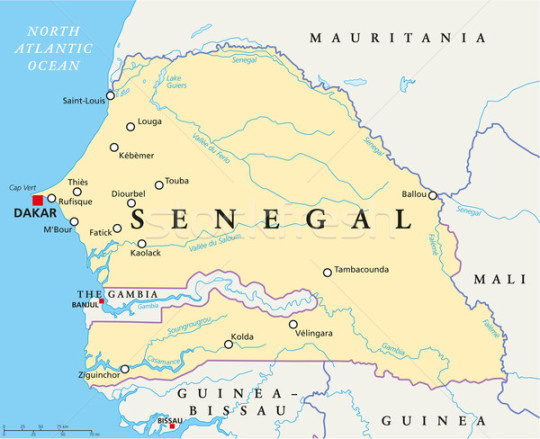
Senegal is located on the west of the African continent.
It lies between latitudes 12° and 17°N, and longitudes 11° and 18°W. Senegal is externally bounded by the Atlantic Ocean to the west, Mauritania to the north, Mali to the east, and Guinea and Guinea-Bissau to the south; internally it almost completely surrounds The Gambia, namely on the north, east and south, except for Gambia's short Atlantic coastline.
The capital Dakar lies on the Cap-Vert peninsula, the westernmost point of continental Africa.
Culture
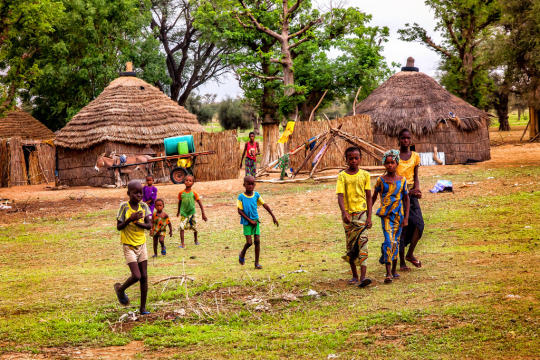
*Wolof village*
Senegal has a wide variety of ethnic groups and, as in most West African countries, several languages are widely spoken.
The Wolof are the largest single ethnic group in Senegal at 43 percent; the Fulaand Toucouleur are the second biggest group, followed by the Serer, the nothers such as Jola, Mandinka, Maures or, Soninke, Bassari and many smaller communities.
About 50,000 Europeans and Lebanese as well as smaller numbers of Mauritanians and Moroccans reside in Senegal, mainly in the cities and some retirees who reside in the resort towns around Mbour.
Also located primarily in urban settings are small Vietnamese communities as well as a growing number of Chinese immigrant traders, each numbering perhaps a few hundred people.
There are also tens of thousands of Mauritanian refugees in Senegal, primarily in the country's north.
According to the World Refugee Survey 2008, published by the U.S. Committee for Refugees and Immigrants, Senegal has a population of refugees and asylum seekers numbering approximately 23,800 in 2007.
Refugees live in N'dioum, Dodel, and small settlements along the Senegal River valley.
SOME WOLOF PHRASES
Welcome
- Merhbe
Hello (General greeting)
- Na nga def (sg)
- Na ngeen def (pl)
- Salaam aleekum
How are you?
- Jaam nga am? (Have you peace?)
- Na nga def?
Reply to 'How are you?'
- Jaam rek, Yow nag? (Peace only, and you?)
- Mangi fi rekk, na nga def?
Long time no see
- Gej na la giis
What's your name?
- Naka-nga sant?
- Na nga tudd?
- Noo tudd?
My name is …
- Maa ngi tudd ...
- ... laa tudd
Where are you from?
- Fan nga joge? (sg)
- Fan ngeen joge? (pl)
I'm from …
- Maa ngi joge ...
- ... laa joge
Pleased to meet you
- Am nàa mbekte ci guiss la
Good morning
(Morning greeting)
- Jaam nga fanane
Good afternoon
(Afternoon greeting)
- Jamm nga yendoo
Good evening
(Evening greeting)
- Naka ngon si
Goodbye
(Parting phrases)
- Ba beneen
- Mangi dem
Good luck!
- Màa ngui lay nianal weurseuk
Cuisine
The basic food is rice cooked with a spicy sauce and vegetables. The national dish is chep-bu-jen,the Wolof word for rice with fish. Cooked in a tomato sauce with boiled fish and a few vegetables (carrots, cabbage, and green peppers),chep-bu-jen is originally from the city of Saint-Louis.Yassa,a dish from Casamance is chicken or fish marinated in lemon juice, pepper, and onions and then baked. It is accompanied by plain white rice. Other sauces include mafé, domada and soupe kandja,(which is made from okra with fish and palm oil).
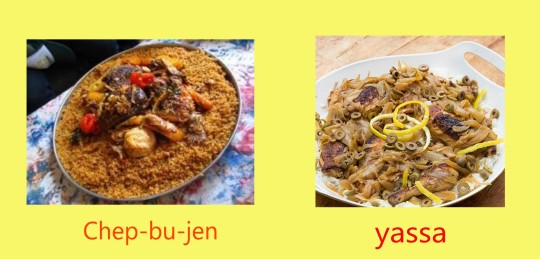
Landmarks
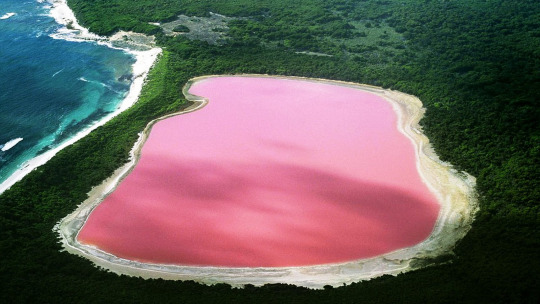
The Lake Retba (Lac Rose meaning Pink lake) - It is named for its pink waters caused by Dunaliella salina algae and is known for its high salt content, up to 40% in some areas.
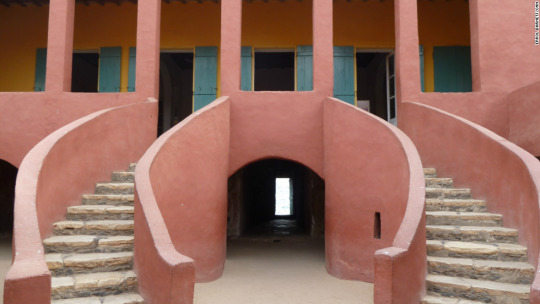
The House of Slaves and its Door of No Return is a museum and memorial to the Atlantic slave trade on Gorée Island, 3 km off the coast of the city of Dakar, Senegal. Its museum, which was opened in 1962 and curated until Boubacar Joseph Ndiaye's death in 2009, is said to memorialize the final exit point of the slaves from Africa.
While historians differ on how many African slaves were actually held in this building, as well as the relative importance of Gorée Island as a point on the Atlantic Slave Trade,visitors from Africa, Europe, and the Americas continue to make it an important place to remember the human toll of African slavery.
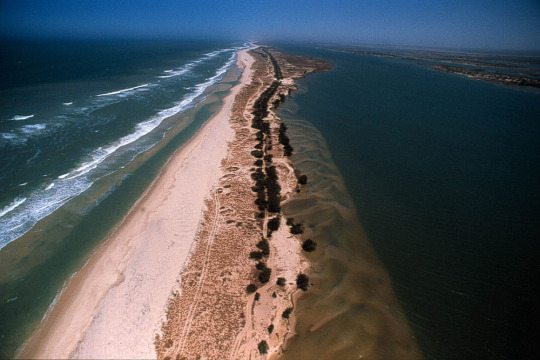
The Langue de Barbarie is a thin, sandy peninsula, adjacent to the Atlantic Ocean, located in western Senegal, in the neighborhood of the city of Saint-Louis. The peninsula separates the ocean from the final section of the Senegal River.
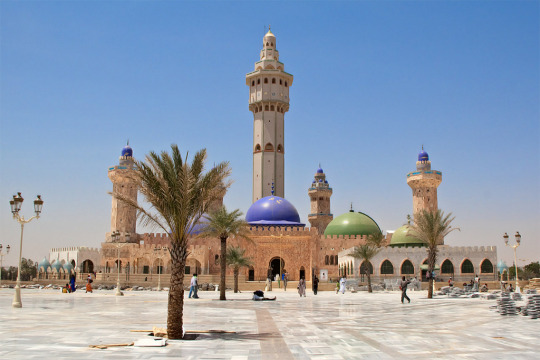
The Great Mosque of Touba is a mosque in Touba, Senegal. It was founded by Amadou Bamba in 1887 and completed in 1963. Bamba died in 1927 and is interred inside the mosque. Since his death the mosque is being controlled by his family.
Some interesting facts about Senegal
1. In the 16th century when the Portuguese visited the country’s coast, the fishermen said “sunu gaal”, which translates into “these are our boats”. The Portuguese, who understood nothing, simply named their land “Senegal”. Classic colonizers!!
2. Senegal’s location towards the west coast made it a hub for the international slave trade of the 18th and 19th century. Gorée Island, in particular, became a major transit point of the Atlantic Slave Trade.
3. In contemporary times, Senegal is very close to France. In fact, the very flag of Senegal has adopted the French Tricolor style. So the flags of both look the same, except for the color
4. Senegal is the only country in West Africa which wasn’t overrun by a military coup. Its democratic stability has earned it many allies in Europe and the Americas.
5. The common lingo of Senegal has a word called, “Teranga”. It has a very sweet and hospitable meaning and has become the identity of Senegalese people. It means helping a person to come to your land and settle down.
6. Dakar is home to the tallest statue in Africa. The African Renaissance Monument built in 2010, stands at an impressive 49 m, but still a meter short of a half-century.
7. Senegal is a paradise for footballers. Many prominent players like El Hadji Diouf, Henri Camara, Ferdinand Coly, Bouna Coundoul, etc. have been inducted into the European League from this country.
8. Senegal’s grasslands have given the country its two national symbols, the baobab tree, and the red lion.
Questions
1. Are you from Senegal or know someone from there?
2. Are you interested in learning Wolof?
3. What’s your favorite thing about Senegal?
4. Do you know anything about Senegal I forgot to mention?
5. Which country/Island do you think I should share about next?
PLEASE INFORM ME IF THERE IS ANY MISTAKE SO I CAN CORRECT IT. THANK YOU :)
*I know I said ISY project is about unknown/less talked about countries but I thought I should share about Senegal since I love it’s people and wanted to know more about their culture.
+ about ISY mini project
+ Previous ISY countries : VANUATU, KYRGYZSTAN .
#I SEE YOU#ISY mini project#SENEGAL#WOLOF#languages#langblr#languageblr#studyblr#history#geography#africa#countries#dakar
3 notes
·
View notes
Text
100 Happy Days Langblr (4/100)

🦟 Myggnett 💤
Nå er jeg så vant til været i Gambia at jeg klager over de siste "kalde" temperaturene - i kveld har temperaturen sunket ned til 20 grader! 😜 Så jeg tok et ekstra teppe til sengen min i tilfelle jeg føler meg kald.
Men de siste kjøligere temperaturer betyr også mindre mygg. Hvis jeg går ut ved skumring, bli jeg bitt innen minutter, spesielt på føttene hvis jeg har på meg sandaler. Av den grunn har jeg ofte spøkt susula mbula! (mandinka: mygg, la meg være!) og maima suma jaama, yo! (wolof: la meg være i fred, mygg!) til mine gambiske venner og kolleger.
Så selv om jeg ofte tar det for gitt, er det takket være myggnettet som henger over sengen min at jeg får god søvn hver natt 😴 Når jeg hører en mygg summende rundt sengen i mørket, har jeg - beskyttet av myggnettet - lyst til å le og banne til dem faen ta deg! 😂
2 notes
·
View notes
Text
Discovering the world
Senegal 🇸🇳
Basic facts
Official name: République du Sénégal (Republic of Senegal)
Capital city: Dakar
Population: 18.1 million (2023)
Demonym: Senegalese
Type of government: unitary presidential republic
Head of state: Bassirou Diomaye Faye (President)
Head of government: Ousmane Sonko (Prime Minister)
Gross domestic product (purchasing power parity): $78.54 billion (2023)
Gini coefficient of wealth inequality: 40.3% (medium) (2011)
Human Development Index: 0.517 (low) (2022)
Currency: West African CFA franc (XOF)
Fun fact: It is home to the tallest statue in Africa.
Etymology
The country’s name comes from the Senegal River, whose name may derive from a Portuguese transliteration of the Zenaga or Sanhaja tribe or could be a combination of the supreme deity in Serer religion, Rog Sene, and o gal, Serer for “body of water”.
Geography
Senegal is located in West Africa and borders Mauritania to the north, Mali to the east, Guinea to the southeast, The Gambia and Guinea-Bissau to the southwest, and the Atlantic Ocean to the west.

There are three climates: hot desert in the north, hot steppe in the center, and dry-winter tropical savanna in the south. Temperatures range from 15 °C (59 °F) in winter to 42 °C (107.6 °F) in summer. The average annual temperature is 28.1 °C (82.5 °F).

The country is divided into fourteen regions (régions), which are further divided into 45 departments (départements). The largest cities in Senegal are Dakar, Touba, Pikine, Kaolack, and M’bour.

History
500-1456: Takrur
1000-1858: Kingdom of Gajaaga
1235-1670: Mali Empire
13th century-1855: Kingdom of Walo
1335-1969, 2019-present: Kingdom of Sine
1360-1549: Jolof Empire
1430s-1591: Songhai Empire
1494-1969, 2017-present: Kingdom of Saloum
1512-1776: Empire of Great Fulo
1537-1867: Kaabu Empire
1549-1879: Kingdom of Cayor
1549-1890: Jolof Kingdom
1549-1894: Kingdom of Baol
1617-1678: Senegambia
1658-1672: Company of Cape Verde and Senegal
1672-1709: Company of Senegal
1709-1758, 1779-1803, 1816-1902: French colony
1758-1779, 1809-1816: British occupation
1776-1859: Imamate of Futa Toro
1852-1893: Tukulor Empire
1867-1903: Fuladu
1902-1904: Senegambia and Niger
1904-1959: Colony of Upper Senegal and Niger
1959-1960: Mali Federation
1982-1989: Senegambia Confederation
1960-1982, 1989-present: Republic of Senegal
1982-present: Casamance conflict
2021: protests
Economy
Senegal mainly imports from China, Russia, and France and exports to Mali, Switzerland, and India. Its top exports are peanuts, gold, and liquefied petroleum gas.
It has abundant iron, gold, natural gas, and oil reserves. Services represent 58.8% of the GDP, followed by industry (24.3%) and agriculture (16.9%).

Senegal is a member of the African Union, the Community of Sahel-Saharan States, the Economic Community of West African States, la Francophonie, and the Organization of Islamic Cooperation.
Demographics
The Wolof are the largest ethnic group (39.7%), followed by the Fula (27.5%), Serer (16%), Mandinka (4.9%), Jola (4.2%), and Soninke (2.4%). The main religion is Islam, practiced by 97.2% of the population, 55% of which is Sunni.

It has a negative net migration rate and a fertility rate of 4.2 children per woman. 49.1% of the population lives in urban areas. Life expectancy is 69.9 years and the median age is 19.4 years. The literacy rate is 57.7%.
Languages
The official language of the country is French, spoken by 27% of the population. The most widely spoken languages are Pulaar (34%), Serer (10%), and Wolof (80%).

Culture
The country is well known for its storytelling tradition through music and words. When two people want to get married, the woman’s family sends kola nuts to that of the man to find out if the family agrees to the marriage.
Men wear a long-sleeved shirt, pants (ṣòkòtò), a wide over-gown (boubou), and a cap (taqiyah). Women wear a loose blouse and a long skirt or a flowing dress (m’boubou) and a head wrap (moussor).

Architecture
Traditional houses in Senegal have mud brick walls and conical thatched or tin roofs.

Cuisine
The Senegalese diet is based on fish, meat, peanuts, and vegetables. Typical dishes include bassi-salté (a stew with meat, tomato paste, and vegetables), chere (millet couscous), dibo (grilled meat with bread, mustard, and onions), ngalakh (peanut butter and baobab pulp with couscous), and tiep (marinated fish with rice, tomato paste, and vegetables).

Holidays and festivals
Like other Christian and Muslim countries, Senegal celebrates Easter Monday, Ascension Day, Whit Monday, Assumption Day, All Saints’ Day, Christmas Day, Eid al-Fitr, Eid al-Adha, Mawlid, and Ashura. It also commemorates New Year’s Day and Labor Day.
Specific Senegalese holidays include Independence Day on April 4 and Grand Magal of Touba on the second month of the Islamic calendar.

Grand Magal of Touba
Other celebrations include the Abéné Festival, a drumming festival; the Dak’Art Biennale, which features paintings and sculptures, and Kaay Fecc, which includes traditional and contemporary dances.

Kaay Fecc
Landmarks
There are seven UNESCO World Heritage Sites: Bassari Country: Bassari, Fula and Bedik Cultural Landscapes, Djoudj National Bird Sanctuary, Island of Gorée, Island of Saint-Louis, Niokolo-Koba National Park, Saloum Delta, and Stone Circles of Senegambia.

Island of Gorée
Other landmarks include the African Renaissance Monument, the Cekeen Tumuli, the Îles de la Madeleine National Park, the Kédougou Waterfalls, and Lake Retba.

African Renaissance Monument
Famous people
Anna Diop - actress
Coumba Gawlo - singer
Fanta Keita - judoka
Ibrahima Kébé - painter
Mariama Bâ - writer
Ofeibea Quist-Arcton - journalist
Ousmane Sembène - movie director and writer
Sadio Mané - soccer player
Tacko Fall - basketball player
Youssou N’Dour - singer

Ibrahima Kébé
You can find out more about life in Senegal in this post and this video.
3 notes
·
View notes
Text
Langblrs I follow
To celebrate having reached 1,000 followers, here is a list of every langblr I follow. I decided to write this post because I wanted to show my appreciation for all these blogs and recommend them to people interested in discovering new accounts to follow.
I subdivided them into Catalan, French, German, Mandarin, Russian, and miscellaneous, according to the language they mainly blog about. I also added other languages they post about or in (except English). The miscellaneous category includes langblrs that either have no main language or one that is not one of my target languages.
Blogs that are active (have posted/reblogged in the last month) as of August 15, 2024 are in bold.
Langblrs
Catalan
goazen (+ Arabic, Basque, Persian, Russian, and Spanish)
guillemelgat (+ Amharic, Bambara, Basque, Bosnian, Kurdish, Malayalam, Romani, Tamasheq, Welsh, Western Abenaki, and Wolof)
langsandculture (+ German, Italian, Spanish, and Swedish)
mar-got-lost-in-translation (+ Russian and Spanish)
mercigracies
segledepericles (+ Italian and Spanish)
useless-catalanfacts
French
bonbonmacaron (+ Japanese, Mandarin, Russian, and Spanish)
chocolateandlanguages (+ Mandarin and Swedish)
coffeeandmagyar (+ Hungarian, Italian, Polish, and Ukrainian)
eevielearnsfrench (+ Spanish, Scottish Gaelic, and Swedish)
efurufrench
fluencylevelfrench (+ French, German, and Norwegian)
fremmedsprak (+ Norwegian)
iprobablyspeakyourlanguage (+ Italian, Mandarin, Norwegian, Portuguese, Spanish, and Swedish)
languageloveaffair (+ American Sign Language, Catalan, German, Icelandic, Italian, Mandarin, Polish, and Spanish)
languagesque (+ Arabic, Japanese, and Spanish)
littlelanguagefox (+ Korean and Spanish)
logogreffe (+ French, Mandarin, and Spanish)
lovinmybaguettes
pawprintedpages (+ Japanese and Spanish)
polyglottraveler (+ Greek, Italian, Portuguese, and Spanish)
polyproject (+ Portuguese)
seraphiclanguages (+ Hungarian, Norwegian, and Swedish)
svensklangblr (+ German, Italian, and Swedish)
vangoghs-other-ear
zsanettgyenese (+ Hungarian, and Italian)
German
a-german-town-every-week
aasho-cotati (+ Arabic, Kurdish, and Somali)
allthingsgerman
astudyinlanguage (+ French, Hindi, and Urdu)
autumnian (+ Italian, Japanese, Portuguese, and Swedish)
berlinlogs
blumensprache (+ Polish and Spanish)
deutsche-bahn
durch-die-tur
foxlanguages (+ Italian, Korean, and Spanish)
german-enthusiast (+ French and Spanish)
gut-gemacht-mien-deern (+ French)
hwiltschek (+ Polish)
ich-bin-der-baer (+ Swedish)
imtryingtolearngerman (+ Japanese and Portuguese)
lang0weilig (+ Italian, and Spanish)
langblrspace (+ Korean and Spanish)
languageoclock (+ Dutch and Norwegian)
learngermanblog
learnoutlive
linguavert (+ Latin, Russian, and Tagalog)
languageundliebe (+ French, and Persian)
mediocrelanguagelearner (+ Czech, Spanish, and Swedish)
polysprachig (+ Dutch and French)
sprachgefuehle (+ Portuguese and Spanish)
sprachschlampe (+ Arabic, Dutch, French, Icelandic, Italian, Mandarin, Norwegian, Russian, Spanish, Swedish, and Welsh)
suplanguages (+ Korean and Portuguese)
thatswhywelovegermany
willkommen-in-germany
zoepanda (+ Greek and Hungarian)
Mandarin
bngrc (+ French)
chinese-word-a-day
levelingupmychinese (+ Spanish)
linghxr
marilearnsmandarin (+ Esperanto, French, Portuguese, and Spanish)
meichenxi (+ German)
ruhua-langblr
slavic-roots-western-mind (+ German and Russian)
Miscellaneous
aurti (Catalan, French, Italian, Portuguese, and Spanish)
ayearinlanguage (multiple languages)
gryffindor2098 (Spanish)
halcyonlanguages (German, Portuguese, Russian, and Spanish)
ibenkoenig (French, Japanese, and Norwegian)
kindofapolyglot (Bulgarian, Danish, Dutch, French, Norwegian, and Swedish)
langsandlit (Catalan, Italian, Neapolitan, and Spanish)
languageek (French, Japanese, Mandarin, Portuguese, and Spanish)
languagelearningcorner (French, Korean, Persian, Portuguese, and Spanish)
languagetrash (French, German, and Russian)
lingcharts (multiple languages)
linguisten (German and Indonesian)
linguisticmaps (multiple languages)
prepolyglot (Ancient Greek, French, German, and Latin)
pythagoreanpolyglot (French, German, Kurdish, Mandarin, Spanish, Tatar, and Uyghur)
sciogli-lingua (French, German, Italian, Portuguese, and Spanish)
teaglach (Asturian, Basque, Breton, Catalan, French, German, Irish, Korean, Portuguese, Spanish, Swahili, and Swedish)
tealingual (Arabic, Finnish, German, Japanese, and Swedish)
terpsikeraunos (Ancient Greek and Latin)
thelanguagecommunity (multiple languages)
thescholarlyseeker (multiple languages)
thoodleoo (Latin)
Russian
haxyr3
how-to-make-mistakes (+ Finnish, French, Greek, and Swedish)
icanlanguageiswear (+ Finnish and Swedish)
italian-native (+ Hawaiian, Italian, Japanese, and Swedish)
learningrussianwithanna
lillelily
pycckuutexas (+ Icelandic)
ruspeach
russianwithpolly
russlangblr
therussianmajor (+ French, German, and Spanish)
#langblr#spanish#english#french#latin#german#ancientgreek#russian#catalan#italian#portuguese#mandarin#arabic
554 notes
·
View notes
Text
I JUST LEARNED HOW TO SAY “HOW ARE YOU” IN WOLOF AND I FEEL SO HAPPY
0 notes